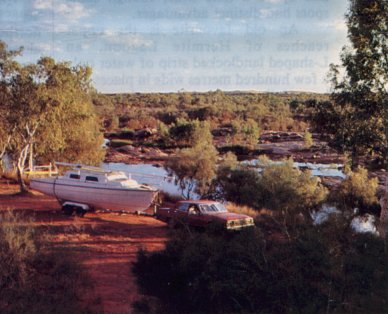from Rob Legg Yachts |
|||||
The Monte-Bellos… The A-Bomb islands of the North WestPart 2 - LEAVING FROM EXMOUTH
Let's say we have finished our six hour drive to Exmouth, which is the basis of a prawning industry and home to the US Navy's Low Frequency Radio Base, as well as half the population of Perth and its southern regions during the winter months (April-August). It's the start of the school holidays but it's not yet crowded at the launching ramp near the Exmouth Yacht Club, while the yacht is rigged and made ready for a more natural environment than the topside of a trailer. The present ramp at Exmouth (soon to be changed, thank heavens) is best negotiated with a large craft at mid tide, as high tide allows the ocean in surge over the sand banks and low tide does not allow anything over the sand banks at all. So with heart in mouth, it's down the ramp, stand on the brakes and away she rolls. (Have you ever tried to push a 2½ tonne boat off by hand?). The small anchorage off the Town Beach must be classed as the most uncomfortable I have used. The tide always seems to run at right angles to the swell and I have yet to have a good night's rest there, although a new break-water under construction further north at Bundegee Reef holds promise. Sunrise saw us steering north east towards Sunday Island with a stiff sou'easter to see us on our way. It was only 20 miles or so but in spite of being able to see the Murion Islands quite clearly to the north, Sunday Island was less than six miles away before we spotted it. Here begins the first lesson on local coastal navigation. These tiny islands can be hard to find as they rise only metres from the sea, so care is needed to avoid costly errors. By lunchtime, Sunday Island was abeam and the previous fine sailing breeze reduced itself to nothing, so we motored the remaining 15 miles to Long Island, bearing almost due east. Long Island is conveniently placed midway between Exmouth and Onslow and as befits its name, is a few miles long with a skinny isthmus near its lower end which forms a beautiful bay with an ideal anchorage in its south-western corner. There is a deep gutter running towards the beach along the lower 'hook' of the bay providing ample depth and very good holding ground, unlike the bay's twin on the eastern side, which tends to have an unreliable bottom. Long Island to Onslow is an enjoyable little sail if care is taken with Wards Reef approaching Onslow and if it's not blowing 40 knots in the exact direction you want to go, as it was in our case. However, a double reef main and reefed number two saw us comfortable enough as there was little sea running, so with a good bit of timing we arrived at the Beadon Creek entrance adjacent to Onslow. This natural creek is very tidal and although it is used by a number of prawning boats as well as the landing barges that ply to and fro between Onslow and Barrow Island, it is best navigated near full tide. Once in the anchoring area, there is plenty of depth for large craft. Go back to Previous Episode | Go back to First Page | Go on to Next Page |

